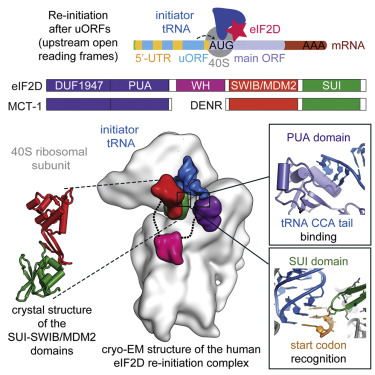Molecular Cell ( IF 16.0 ) Pub Date : 2017-07-18 , DOI: 10.1016/j.molcel.2017.06.032 Melanie Weisser , Tanja Schäfer , Marc Leibundgut , Daniel Böhringer , Christopher Herbert Stanley Aylett , Nenad Ban

|
After having translated short upstream open reading frames, ribosomes can re-initiate translation on the same mRNA. This process, referred to as re-initiation, controls the translation of a large fraction of mammalian cellular mRNAs, many of which are important in cancer. Key ribosomal binding proteins involved in re-initiation are the eukaryotic translation initiation factor 2D (eIF2D) or the homologous complex of MCT-1/DENR. We determined the structures of these factors bound to the human 40S ribosomal subunit in complex with initiator tRNA positioned on an mRNA start codon in the P-site using a combination of cryoelectron microscopy and X-ray crystallography. The structures, supported by biochemical experiments, reveal how eIF2D emulates the function of several canonical translation initiation factors by using three independent, flexibly connected RNA binding domains to simultaneously monitor codon-anticodon interactions in the ribosomal P-site and position the initiator tRNA.
中文翻译:

对人类重新初始化复合体的结构和功能见解
翻译了短的上游开放阅读框后,核糖体可以重新启动相同mRNA的翻译。此过程称为重新初始化,可控制大部分哺乳动物细胞mRNA的翻译,其中许多在癌症中很重要。参与重新启动的关键核糖体结合蛋白是真核翻译起始因子2D(eIF2D)或MCT-1 / DENR的同源复合物。我们结合低温电子显微镜和X射线晶体学技术,确定了与人类40S核糖体亚基结合的这些因子的结构,这些蛋白与位于p位点mRNA起始密码子上的启动子tRNA形成复合体。这些结构得到了生化实验的支持,揭示了eIF2D如何通过使用三个独立的,



























 京公网安备 11010802027423号
京公网安备 11010802027423号